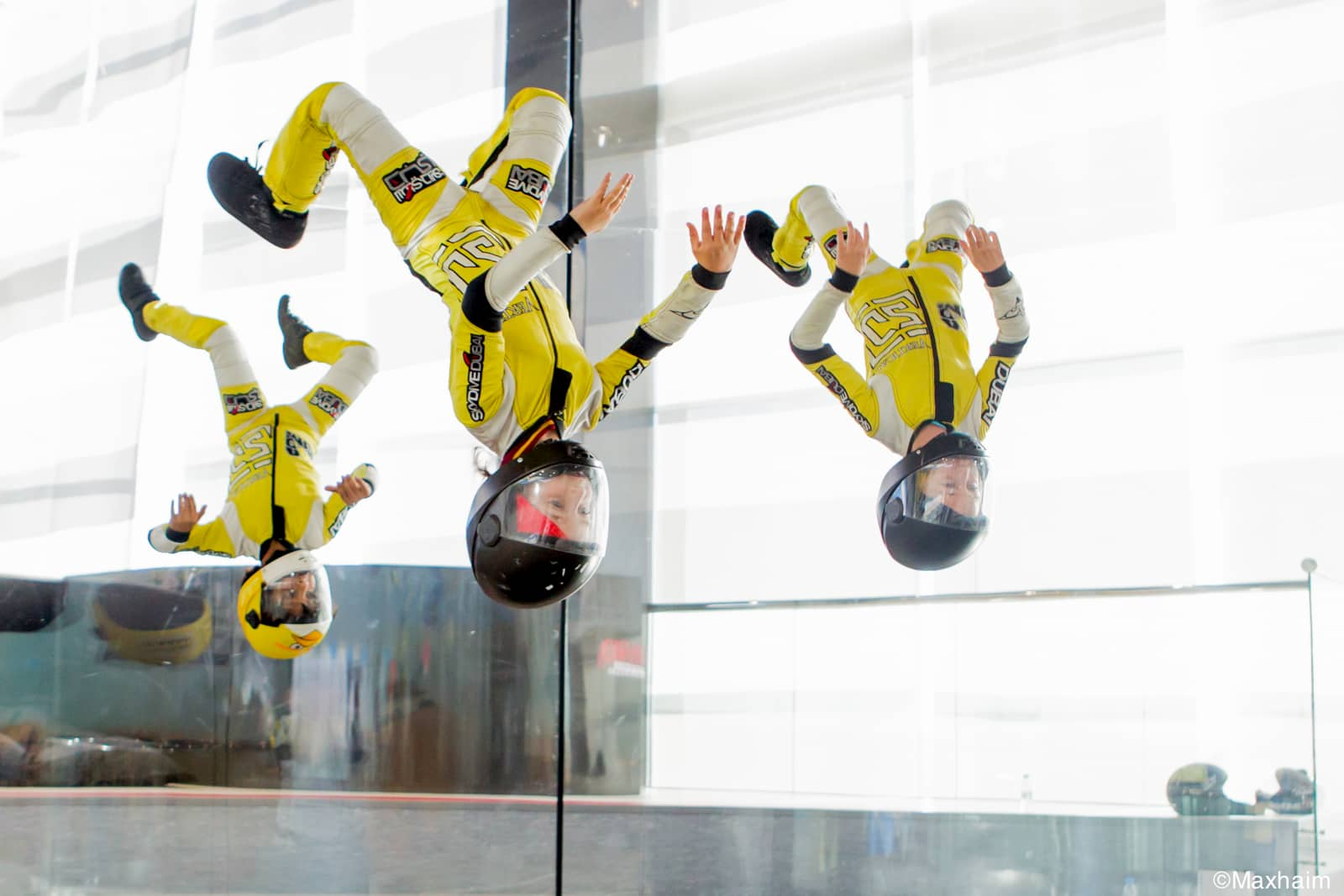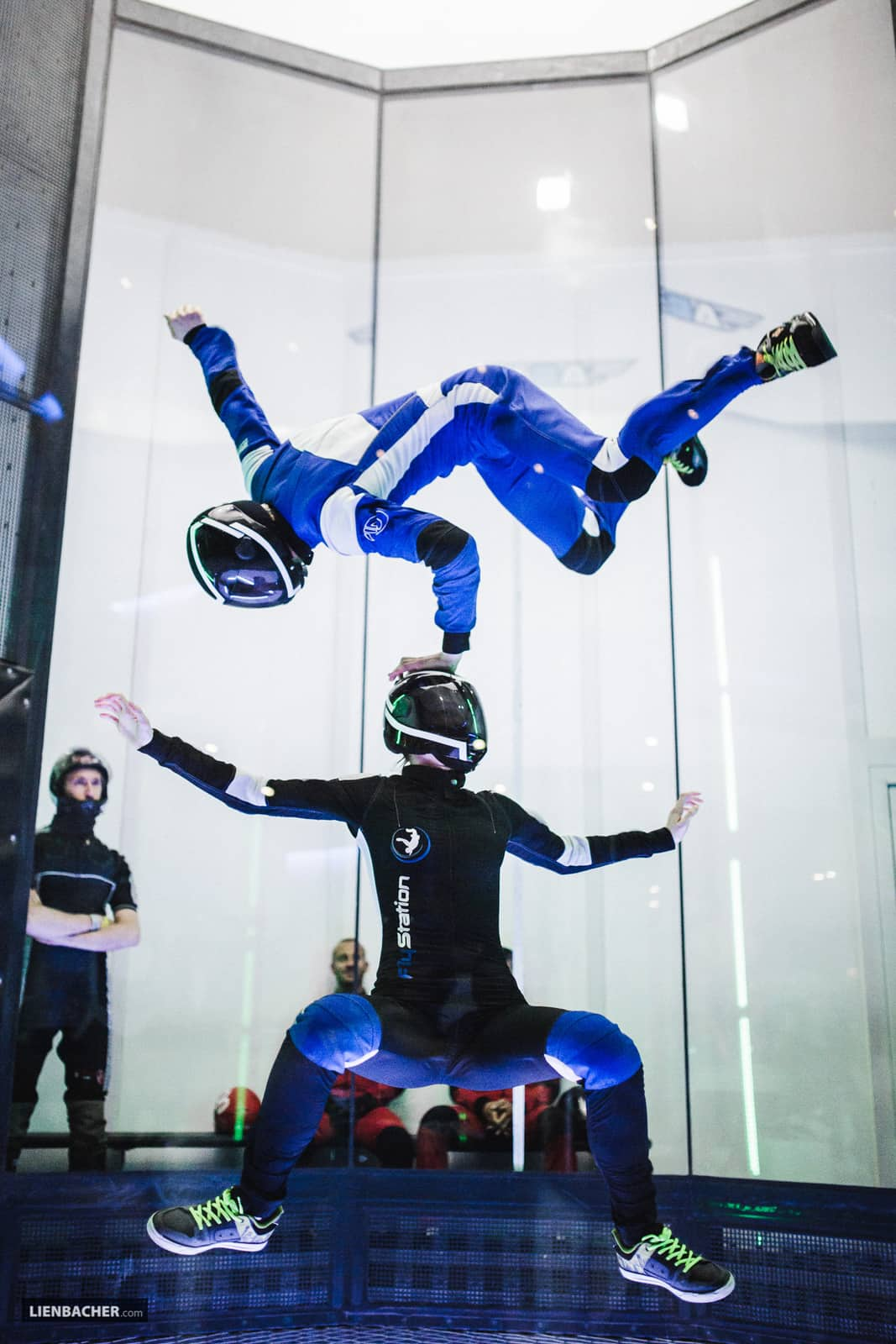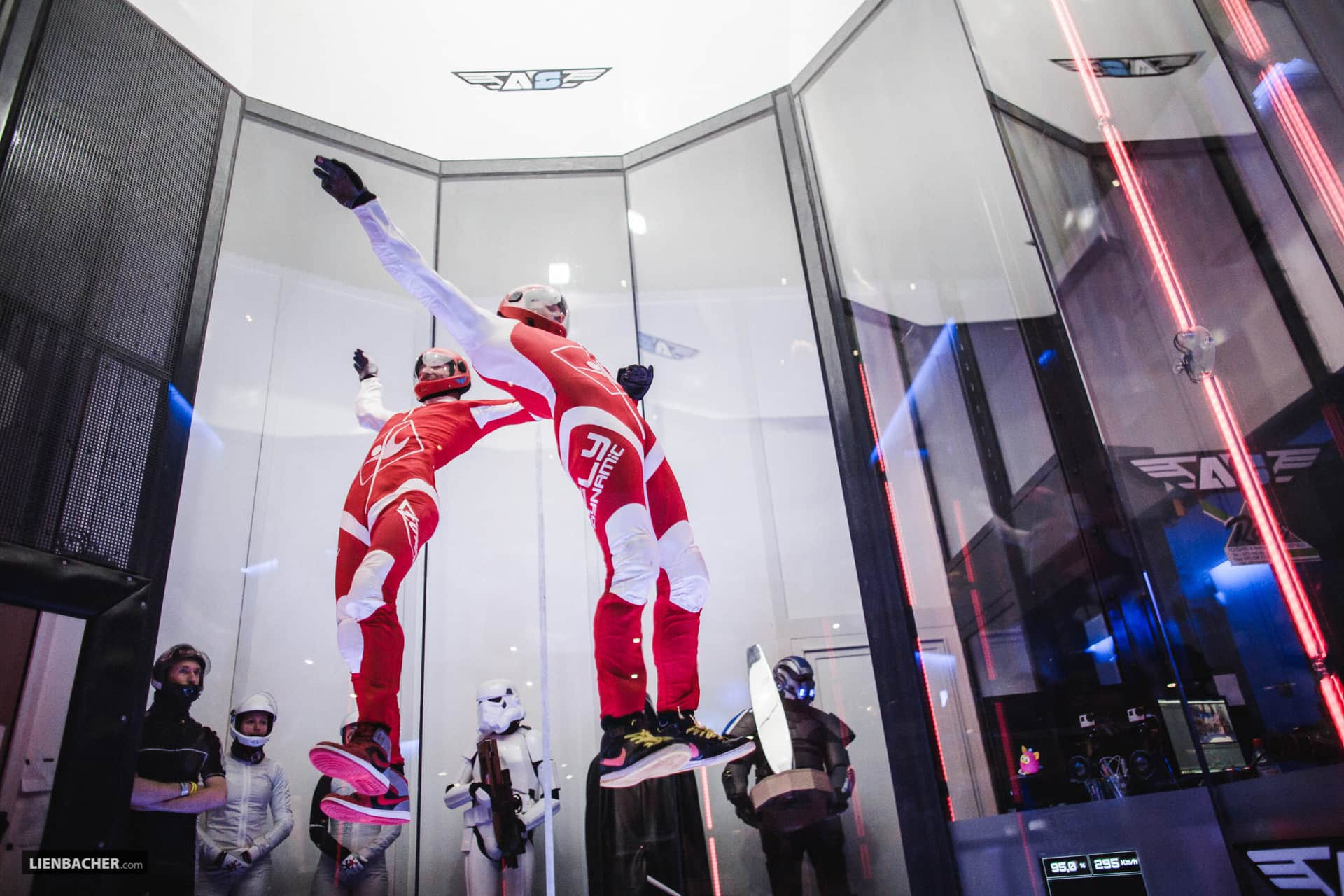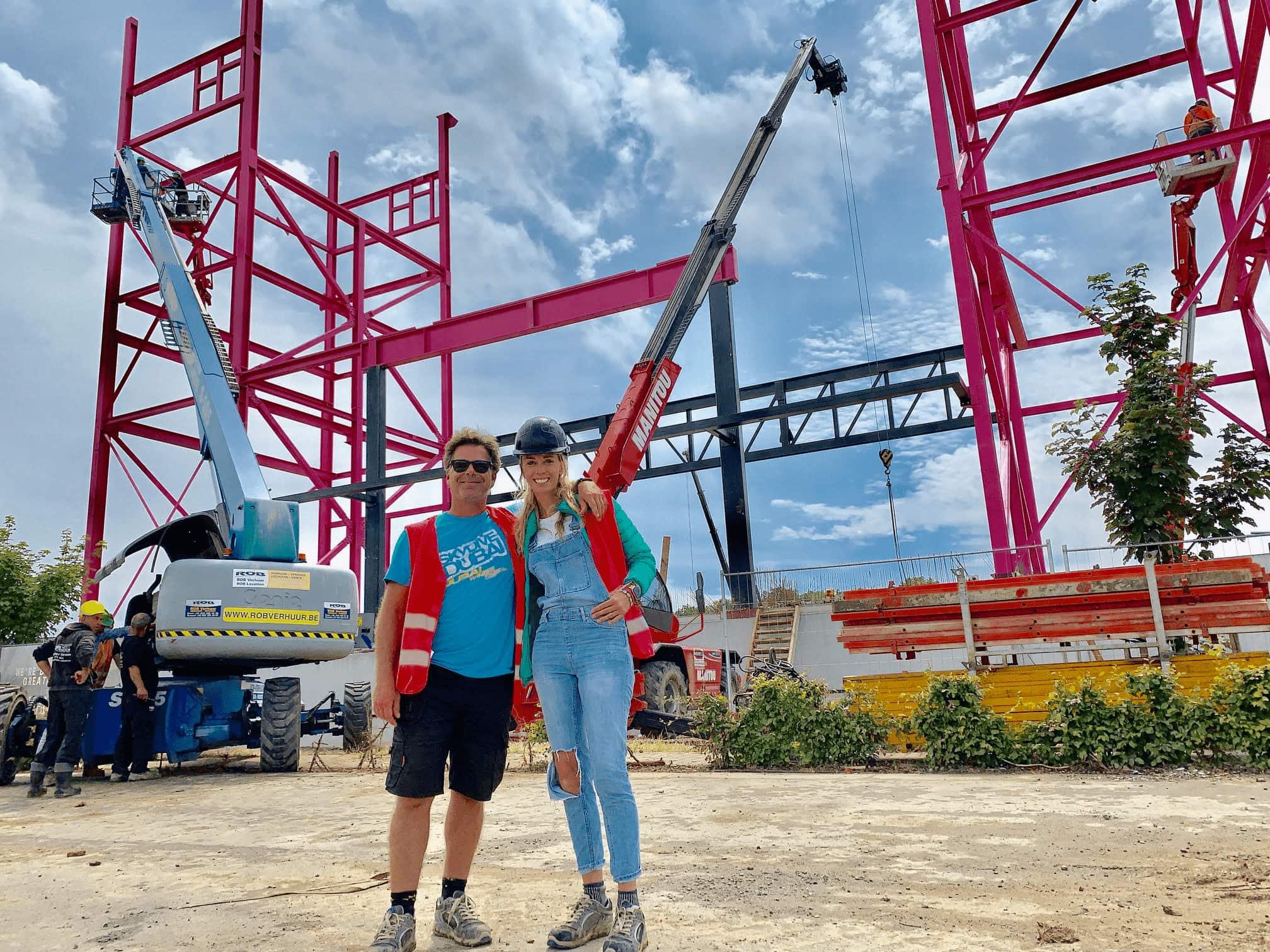Find an Indoor Skydiving Location Near You
Add New Wind Tunnel
Select Your Country
Latest Indoor Articles
The Business
As is true with much technology, wind tunnels began as a military thing. Vertical tunnels were first created during the inter-war period of the last century as a means to test aircraft designs, parachutes and such, and then grew progressively in scale along with our ambitions to kill each other in new and exciting ways. Humans are a predictable species, so after some lunch-break conversations in the 60’s - a NASA employee called Jack Tiffany got inside to give it a go.
Naturally, the next step was turning it into money. By pointing old aircraft engines upwards though a steel net and padding the surrounding area, a product was created and the experience then sold to skydivers and ground-dwelling folk alike. Looking back on these initial designs through modern eyes these contraptions were not up to much – with low power and massive suits - but the door was now open.
In the late 90’s a US company called SkyVenture filed a patent for a new kind of tunnel. An electric solution that would use a vacuum instead of the expulsion of air outwards, and it would be fast. Through serendipity or some kind of convergent evolution of thought, this was exactly the same time that some people in the sky were figuring out new ways to fall by using their bodies to control speed, angle and orientation and fly freely through all available axis – this new development would be called Freefly.
Quickly proven as an effective training method for skydiving, money was being made by indoor skydiving - and new designs were being approved and put into construction. Crucially, there was now one in Arizona that was fast enough to freefly in. Very soon, the first modern generation of tunnel instructors quickly set about flinging themselves into the walls to figure out how to fly the new way, and to then develop safe ways to pass their skills on to others.
The designs continued to evolve, with things like recirculating air, temperature control and bigger flight chambers lowering the noise and expanding the market. Tunnels began to make a lot of money - great big piles of money. Seeing the potential, other companies also started to build tunnels - most notably in Europe. An outfit called Indoor Skydiving Germany started putting up designs that were kind of different but kind of the same as the others which made SkyVenture very mad and sad, and legal shenanigans began.

The really short version of the story is this: SkyVenture tried to sue ISG out of existence by stating that they owned the very concept of an indoor skydiving wind tunnel. A claim that American lawyers found merit in, though was objected to by European lawyers. The result was that nobody but SkyVenture could build tunnels is the USA (and a few other places, like Britain and Australia) but everywhere else anyone with the means to do so could have at it. Tunnels began to spring up all over the place, with bigger and fancier examples opening on a month by month basis. In Europe, a handful of main players were gobbling up prime locations and the competition between rival storefronts began to heat up. With a SkyVenture monopoly in America keeping prices up and increasingly intense rivalry on the other side of the Atlantic driving them down - Europe was by far the cheapest and therefore most appealing and place to go and fly.
For a while, this price disparity drove progress forward in the European indoor skydiving scene at a faster rate and this is where the modern industry we recognise was created. Advances in coaching technique meant that people were getting better faster, and with that the competition formats used at the highest level were born. These days, through the efforts of many very good flyers and coaches in the USA and around the world, the gap has narrowed so much as to almost warrant the exclusion of writing about it here - yet the historical aspect makes it relevant. Europe was the centre of the flying world.
To business types, the numbers generated by various wind tunnels across the globe showed them to essentially be money printing factories. All you had to do was have enough money to build a facility in the first place, then after a brief few years to recoup expenses you would own a machine that creates vast amounts of cash forever. This is very much not the case. Tunnels are everywhere now and the market increasingly diluted. Larger cities now have two or even three competing companies and things are becoming tough for some.
While indeed the industry continues to grow, the market is volatile and profit is by no means a sure thing. There are big, expensive tunnel facilities out there that haemorrhage money and are in real danger of closing. There are some that operate a skeleton crew - only opening when a profit can be squeezed. Some have already closed and there will be more that don’t make it. In 2019 the land grab is very much still happening, but it is not the money banquet the suits perceived and there has been some scaling back of ambition - and even a reduction in the size of the tubes being put up. By far the most valuable time a tunnel sells is a couple of minutes each to the general public - to the point where if that base is covered they don’t even need to be concerned with the size and power of tube the sport flyers desire. While the 14ft chamber is overall still the most popular for owners and flyers alike, allowing all the types of sport training alongside the leisure business - an increasing number of smaller and more cost efficient tubes are being commissioned.
For the flyers though, things are only getting better. With an ever growing community and continually decreasing prices, developing your flying skills now happens faster than ever before. Tunnels know that their customer’s business is incredibly valuable and bend over backwards to treat them well, and there is a strong network of very capable coaches in all disciplines.
How Indoor Skydiving Works
Tunnel Size
While back in the day there was no real standardised size for a tube, they trended on the smaller side with the first modern re-circulating examples being 12ft across. This was seen as adequate for what everyone was doing at the time.
Through a combination of better, more efficient designs and the desire for a little more room – a 14ft diameter became the chamber of choice.
This presented a sort of chicken-or-egg situation where the technique changed with the bigger tunnels helped to usher in new styles and methods of training – in turn making the older smaller tunnels unsuitable for at first a part of how things were done, but now a huge part of it.
The short version is this: in a bigger chamber you could do a couple of things differently…
1. You could apply more of your body to the wind more of the time. The more of your surface area you use, the more efficient your flying is and the easier it is on your muscles and energy levels.
2. There was now space enough for a coach and a student to fly together using these new techniques. By one following the other it was possible to learn not only how to do the moves, but also how to interact with other flyers and to manage pathways through the space – all at the same time.
Bigger or Smaller?
The big boom of tunnel construction continued, and with it an arms race to own the biggest and fastest in the world. Across the years a selection of 16ft and even 17ft facilities were created around the world in an effort to entice more of the international business their way and secure some market share (or just for the sake of fancy). While luxuriating in one of the available big tubes is very nice, you will be paying extra for the privilege – and in terms of personal training, everything can be achieved in a 14ft tunnel and they are significantly more affordable. While going smaller than 14ft is an economical option - space and movement are limited and you will be constrained somewhat in your training – forced to focus more on static work.
Indoor Gear
In the simplest terms a jumpsuit is clothes that don’t come off while you are flying about. At the same time, suit design is very technical and complicated - presenting you with an obfuscating minefield of options and opinions about materials and panels and styles and sizes. The purists view is that a suit should fit your body like a second skin, because the goal is to learn to fly your body rather than some material that is not your body. In real practical terms, jumpsuits represent a toolbox out of which you can select that which suits best your style of flying and your level of experience. At the start don’t worry about it - borrow something to get going and use the time to learn about what is available, what you need and why you need it. The poshest examples on the market are incredibly well made and will cost you the lion’s share of a thousand monies. These are great but do proper research and consider what you really need before splurging because fancy.
You will need a helmet. A cheapo multi-sports brain bucket will do the job for you but there are some swanky examples designed specifically for flying. While the open faced helmet has some supporters, the overwhelming majority of people prefer something that covers your entire mug for both comfort and better overall protection. Old full-face helmets were shit, but now a lot of attention is paid to the ability to communicate properly by allowing visibility of the whole face, and include an unencumbered field of vision. Recent seasons have seen a growing concern over the level of real protection offered by the helmet options available to skydivers and tunnel flyers – as traditionally there has been no legislation stating the need for impact protection. This has now been addressed with the high-end examples complying with a specifically tailored new skydiving rating - making them subject to all sorts of tests before they can qualify and be sent to market.
Ear protection is mandatory. Tunnel technology gets progressively less noisy, but the combined volume of wind and motors inside the chamber make it essential to protect your hearing. There are various kinds of elaborate moulded technological super duper ones, but they get nasty when you forget to clean them and they are tremendously easy to lose. Disposable earplugs are best and are freely available at the tube. Don’t throw them away after every session though, as although disposable in nature you can use a pair for ages if you hang on to them. If a plug comes out when you are flying, stop and fix it. They will probably pause the time for you and your hearing is important.
It is possible but not smart to fly without shoes as the walls are hard and the net can be stabby where the wires have frayed. Poke your laces away properly though or they will come undone and whip you on the leg. Make sure you do them up tight because if you lose one in the tunnel the experience ranges from embarrassing to terrible. Best case scenario it goes through the machinery clean and it is returned to you whole after short delay. Worst case scenario it gets caught in one of the fans then chopped up and/or melted, causing a long shutdown and a nasty smell throughout the building.
Base layers are a good idea as they are comfortable under your suit and good for your muscles – helping to avoid pulls and strains. If you begin to fly regularly they are a sound investment. There are all sorts available and tunnels will sometimes have some of their own to sell you. Base layers range in price from super cheap to pretty spendy – either being just some crappy stretchy fabric all the way through to swishy tech super duper science material.
Gloves are optional. Some people swear by them, other people think they are stupid. If you decide to forego gloves when flying, you will still probably want to use some when learning static head down because it involves grabbing the net at the beginning.
Buying and Using Time
Flying in the tunnel is not cheap, but allows you to learn new skills in a controlled environment with direct and very precise feedback. Time is sold by the minute, but sports flyers will more often engage with it at a financial level by the hour – and that is how companies and coaches will advertise things. Like most shopping, buying in bulk is the way to reduce the price. Offers also exist that will include a bonus of free time if you buy a certain amount, such as buy ten hours and get one free.

Many companies throw in other perks to entice your business in their direction, such as free airport transfers, included meals and use of on-site hotel facilities. Always remember that tunnels are flexible on price. Many places are likely quite desperate for your business and will go much further than what is advertised to commit you on a sale – so don’t be afraid to phone them up a play hard-to-get. Your time will be uploaded to an account somewhere online where you will have the ability to login and book sessions. Once booked you will have some flexibility but be careful to understand properly the particular terms and conditions of your time as it can change or have restrictions under certain circumstances. Time you bought in a special offer might have some very limiting factors, so always confirm the ins-and-outs before you pull the trigger.
Sessions and Rotations
Exactly how a tunnel runs things changes a bit from place to place, but as a general rule the day day will be split into 30 minute sessions. Although for the sake of logistical efficiency some effort is made by tunnel companies to separate sport flyers and newbies, any given session can contain a mixture of any and every type of flying.
Time in a session is broken up into rotations. Rotations are chunks of time from a single minute up to anything as high as five - and different disciplines, drills, preferences and situations all require various lengths of rotation depending what is going on. Tunnel training can be very tough on you muscles, and choosing the correct rotation length combined with smart planning makes a big difference to how fast you progress. There is some small amount to learn here about how sessions are put together when you fly and it is well worth investing the time to do so. It is easy to look like a boob if you don’t spend a few minutes communicating your intentions to the tunnel staff, but if you do this well they will be nice to you.
Instructors
An instructor is a human that has made a Faustian pact with a tunnel company. By exchanging their soul for a period of time (usually a couple of years), the instructor gets to fly. Hopefully, they get to be good - but that is not a given. They have to work like a dog for it. An instructor’s primary function is to teach basic skills to classes of the general public and fly them for a couple minutes at a time. They are also there for the safety of everyone who enters the tunnel regardless of skill level, and are present during every session. If you are nice and communicate well with the instructor team they can do wonderful things for your flying life.
If you are thinking about becoming a tunnel instructor the only question you need to answer is this: Is getting good at flying the single most important thing in your life? If yes, it can be very worth it, as with effort the doorways to your zoomy dreams slowly begin to open. If no, it can be very not worth it as you thanklessly toil away at a physically demanding job for the smallest amount of money they are legally allowed to pay you.
With so many tunnels now up and running around the world – it gets progressively easier to get a tunnel job. There is still a lot of competition for a position though, and if you are in the running try to remember that the owners of the company generally don’t give a rat’s ass that you want to be the best flyer in the world – they are looking for reliable members of a small team that are good with people and enjoy teaching to the brand new.
Coaches
A coach is generally someone who sells their skills for money independently of the tunnel. They might work at the tunnel but coach outside of their working hours, or be someone from the dropzone who also offers tunnel coaching as a service. Paying for coaching on top of tunnel time is expensive, but good coaching is very worth the money and will get you much further than trying to either figure it out by yourself or using the hit-and-miss approach by using whatever the tunnel is offering for free by way of their instructor staff.
A good coaching relationship with someone who gives you the right information at the right time, and who pushes you forward at the very best pace is a valuable thing. When looking for a coach, do your research properly. Ask around in your local flying community to find out who is appropriately experienced and well respected. There are many excellent coaches and just as many terrible ones. Don’t be afraid to try a few to see who fits the best. A good quality coach will not mind you flying with others as they understand that there is much to be gained from variety.
Skydiving and Tunnel
The overwhelming majority of tunnel flyers are also skydivers. There are many tube kids who are not yet old enough to jump, and indeed a rare few people (even the odd instructor) that are indoors only. Mostly though, to some degree or other people are using the tunnel to further their ability in freefall.
At the beginning it is difficult to perceive the differences, but as you progress you will start to notice and learn more about the two flying environments. The further you go in your career the more you will understand about how the training methodologies expand and diverge into separate forms (sort of). Although on a basic level a lot of the training can often be separated into a tunnel thing and a sky thing - the ways that the drills and techniques form a symbiotic relationship add up to more than the sum of their parts. With the correct guidance you can learn a great deal about one from the other. A good coach will be able to explain at length the ways all of the training benefits one environment or the other, and the universal lessons that are true for both.
Going Deeper
Once you have got yourself set up and spent a bit of time at the tube, you will start to notice all the different things that are happening the you might want to be involved in. The stuff below is pretty standard, but your local spot might have some wacky things going on that only they offer as well.
Scrambles
This is an informal competition format held usually across a single day or evening. Participation is generally not restricted in any way but might involve a few requirements relating to flying ability. The organisers will likely aim to form up the flyers into teams of somewhat equal strength and have at it. This format existed before freefly was even a thing, but these days you will find freefly scrambles available just as much as those for belly flyers. While skills can definitely be learned, these events are really more about having fun and developing social connections with the flying community that will lead to new and interesting places.
Huck Jams
These events are informal freefly gatherings designed around sharing the tunnel with others. The advantage for the flyers is the relative affordability of sharing time. The advertising material will usually confirm you get a certain total of minutes guaranteed by the price - split between solo and shared flying. There is a lot to learn about how to interact in the tunnel with other people and well organised and coached huck-jams can be a great place to dive in. Be assertive though, as things can easily turn to chaos and sometimes people get swept up into uncomfortable situations or left behind. This depends on the quality of the organisation - a well executed huck jam can be the best time you ever have at the tube.
Kids Club
Most tunnels operate some kind of children’s membership scheme - usually offering a discount rate for those under a certain age, hoping to milk a bunch or rich parents for as much as possible. Children are small, which means they have more space - thus making everyone very jealous.
Flying Clubs
Your local tube very much wants your repeat business and might have some kind of loyalty scheme in place to entice you into offers and deals. It is worth investigating what perks might be on offer - ranging from cheaper time to merchandise or snacks etc.
Teams
Competitive flying is a thing both indoors and outdoors. Your tunnel will likely have some form of training going on with people in matching gear looking very serious about it. Being in a team is a demanding but rewarding endeavour. It takes time, effort and resources to build the skills and patience, tolerance and mental strength to operate under the conditions of competitive bodyflight. With the right mind set and appropriate work ethic, a team can be both positive social experience and provide a structure to your flying career that sees you improve year after year.
Competitions
Back when tunnels got serious, the ways people competed to decide who was best were pretty much the same as they did in the sky. As indoor flying evolved into something new and different, competitions needed something new and different too. While the old familiar disciplines remain, new formats for the indoor environment have been created with a healthy, growing community that supports them. Competitions began to happen all over the place, mostly fronted by the tunnel companies using them as promotional opportunities. Whoever won got to be the best, but only until the very next competition - which would sometimes be just a few short months away.
Humans require to win and lose, and the flying community needed a world championships. With clashing corporate interests and a disparate, informal structure of influential people it was proving difficult to get set up. The tunnel community was too small to develop the resources to produce and manage the systems needed to coordinate a worldwide organisational effort. Meetings were met and talks were talked and the tunnel people threw in with the Federation Aeronautique Internationale – the airsports organisation responsible for everything from skydiving to airships - to get it going. The FAI had all the documentation and the processes in place to run international competitions, and so they began.
There is an official indoor skydiving world championships every two years - which is good thing but not without problems. The positive side is that formalising things is helping the sport to grow, the negative side is that the sport is evolving faster than the procedures conducted by the FAI are able to move. The influence of skydiving’s old guard means that the steps we should be taking towards immediacy and vitality are too few too late. The showcase disciplines of indoor skydiving are gathering attention outside of the community, but the structure of the competitions are at this point still baffling and incomprehensible to the casual viewer. The very highest levels of skill on display are outshone to the tune of millions by someone flopping about in fancy dress. Despite the problems, indoor skydiving is getting more recognition now as a regular sport rather than a curiosity. Led by the French there was a big push to get it into the Paris 2024 Olympics. Unfortunately, the bid was not successful – but many lessons were learned that can be applied to continued progress.
Indoor Skydiving Disciplines
Relative Work / Formation Skydiving
The original way to skydive was flat with one’s belly pointing towards the earth. Once people figured out how to control themselves and get close enough to form different shapes by joining their arms and legs, competitions soon followed. The indoor format for this is transplanted exactly form skydiving – except losing the camera flyer. There are block ands randoms. A block describes the movement from one shape to another. A random is just the shape itself. Competitive belly flying is at the pointy end both complicated and serious, yet the starting point of a basic orientation allows for relatively easy access and the scene has a huge social aspect.
Vertical Formation Skydiving
VFS is basically the same as the way belly flyers do things, only using the static freefly orientations of head up and head down. The dive pool uses the same nomenclature of blocks and randoms which are built from the four flyers switching very quickly between the orientations.
2-Way VFS comes and goes. In the days before Dynamic turning freefly points was the compulsory element of freefly competitions but was replaced in favour of more movement. Indoor 2-way VFS is at the time of writing not in the list for world level competitions but will frequently be included at national level to help bolster attendance and will pop up here and there at casual meets and scrambles.
Freestyle
In the tunnel, freestyle is a solo discipline where the performer creates a a free routine lasting for sixty seconds and is judged throughout five rounds on the criteria of technical difficulty, presentation and execution. The competition format also includes two compulsory rounds in which all of the competitors are required to perform the same moves.
Between the tunnel and the sky Freestyle is not much different. The solo performer becomes a team with a camera flyer. The competition format is basically the same with just a couple of differences to the compulsory move between the two environments.
In the sky there is another artistic category using freefly as its title – with two performers and a camera flyer. In the tunnel, this artistic element is part of Dynamic 2-Way.
Dynamic 2 + 4 Way
Dynamic competitions were created alongside the developmental changes in the way we train indoors. A greater understanding of how to use the space of the tube created a desire for a new competition format that could be at once more representative of how we were starting to fly, but would also lend itself to greater immediacy and be more appealing and connective with the viewing public.

Dynamic competitions have an artistic element where teams create free routines in both 2-way (60 seconds) and 4-way (90 seconds) the competition structure also employs a kind of race using a pool of different sequences of snakes that go around in a figure of eight, layouts that go over and under and shufflers that well, shuffle.
Where the flyers – be they two or four in number.
Solo Speed
This is simply the speed round element of the dynamic competition format, only presented as a competition on its own with a single flyer. While currently not included at world level, it is growing in popularity.
Mixed Formation Skydiving
MFS was developed as a way to give people stepping-stone access to the more difficult and complicated VFS. It works in much the same way but uses the relatively easy orientations of belly and back flying to construct the dive pool.
MFS has some interesting aspects in the skydiving environment – such as the ability to self judge without an external camera and to fly a full competition round from lower altitudes. Indoors there is no real fixed format, but event organisers all around the world will use some form of intermediate dive pool with similarities to MFS as a means for flyers of all levels to get involved in what they are doing.
Where We Are At
In less than two decades, the indoor skydiving industry has gone from an interesting experiment to an established leisure industry business model and a fast-growing sport. At the time of writing there are hundreds of tunnel facilities all around the world at many more on the way. While the boundless ambition of the technology companies has tapered off somewhat, many more facilities are on the way in almost everywhere you care to think of. What people able to do in the tube continues to evolve and as yet shows no signs of slowing down, and while crossover success in the world of sport remains out of reach, it is a very real goal for the future.
Competition around the world between tunnel companies is fierce and the market is tilted heavily in favour of the customer. Utilising efficient coaching techniques and ever cheaper time, new flyers progress incredibly fast – developing levels of skill in periods of time that even just a few years ago was unfathomable.
There has never been a better time. Go get some!


